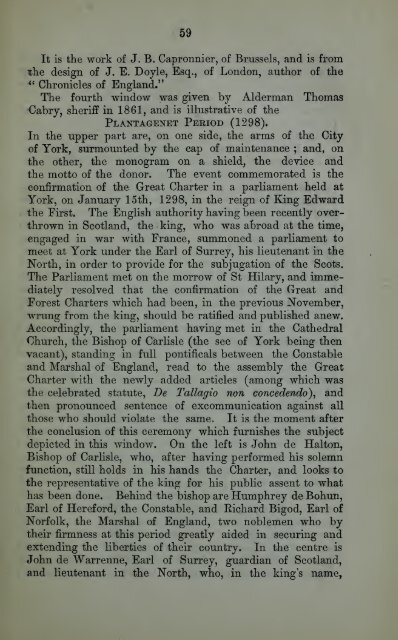practicalguideto00unse_0
Create successful ePaper yourself
Turn your PDF publications into a flip-book with our unique Google optimized e-Paper software.
59<br />
It is the work of J. B. Capronnier, of Brussels, and is from<br />
the design of J. E. Doyle, Esq., of London, author of the<br />
Chronicles of England."<br />
The fourth window was given by Alderman Thomas<br />
Cabry, sheriff in 1861, and is illustrative of the<br />
Plantagenet Period (1298).<br />
In the upper part are, on one side, the arms of the City<br />
of York, surmounted by the cap of maintenance ;<br />
and, on<br />
the other, the monogram on a shield, the device and<br />
the motto of the donor. The event commemorated is the<br />
confirmation of the Great Charter in a parliament held at<br />
York, on January 15th, 1298, in the reign of King Edward<br />
the First. The English authority having been recently overthrown<br />
in Scotland, the king, who was abroad at the time,<br />
engaged in war with France, summoned a parliament to<br />
meet at York under the Earl of Surrey, his lieutenant in the<br />
North, in order to provide for the subjugation of the Scots.<br />
The Parliament met on the morrow of St Hilary, and immediately<br />
resolved that the confirmation of the Great and<br />
Forest Charters which had been, in the previous November,<br />
wrung from the king, should be ratified and published anew.<br />
Accordingly, the parliament having met in the Cathedral<br />
Church, the Bishop of Carlisle (the see of York being then<br />
vacant), standing in full pontificals between the Constable<br />
and Marshal of England, read to the assembly the Great<br />
Charter with the newly added articles (among which was<br />
the celebrated statute, De Tallagio non concedendo)^ and<br />
then pronounced sentence of excommunication against all<br />
those who should violate the same. It is the moment after<br />
the conclusion of this ceremony which furnishes the subject<br />
depicted in this window. On the left is John de Halton,<br />
Bishop of Carlisle, who, after having performed his solemn<br />
function, still holds in his hands the Charter, and looks to<br />
the representative of the king for his public assent to what<br />
has been done. Behind the bishop are Humphrey de Bohun,<br />
Earl of Hereford, the Constable, and Eichard Bigod, Earl of<br />
Norfolk, the Marshal of England, two noblemen who by<br />
their firmness at this period greatly aided in securing and<br />
extending the liberties of their country. In the centre is<br />
John de Warrenne, Earl of Surrey, guardian of Scotland,<br />
and lieutenant in the North, who, in the kings name,















